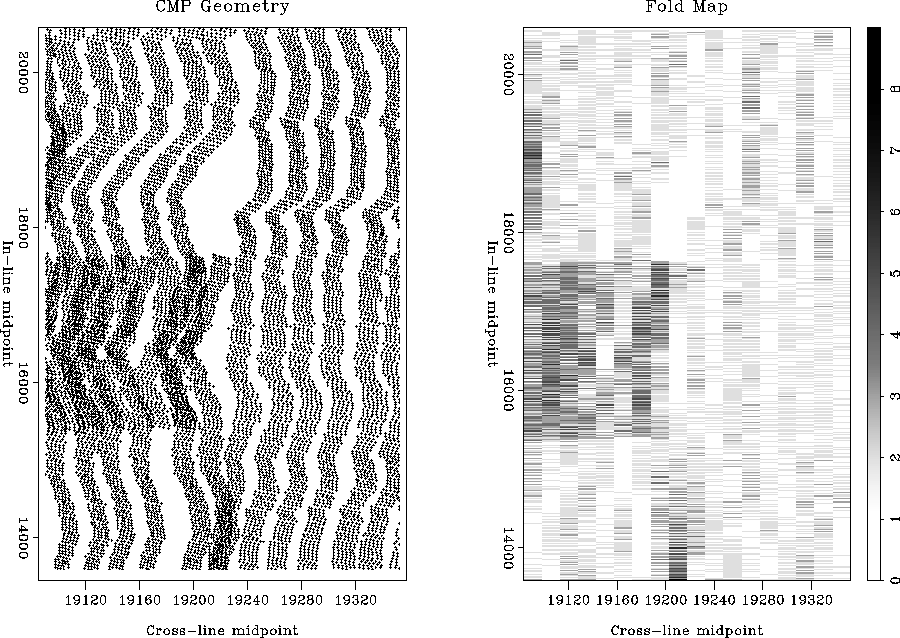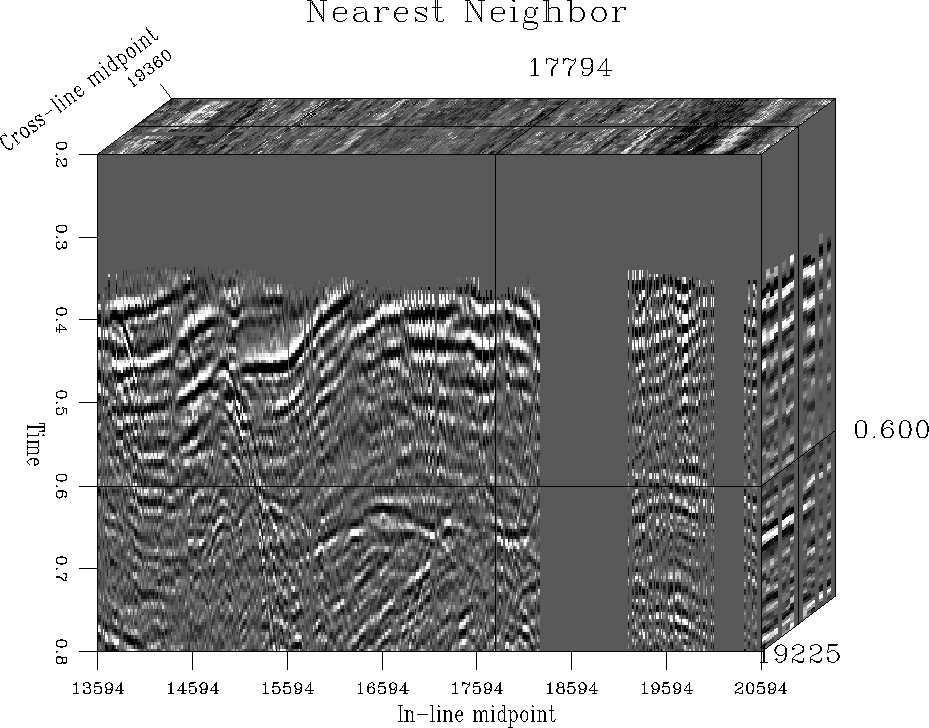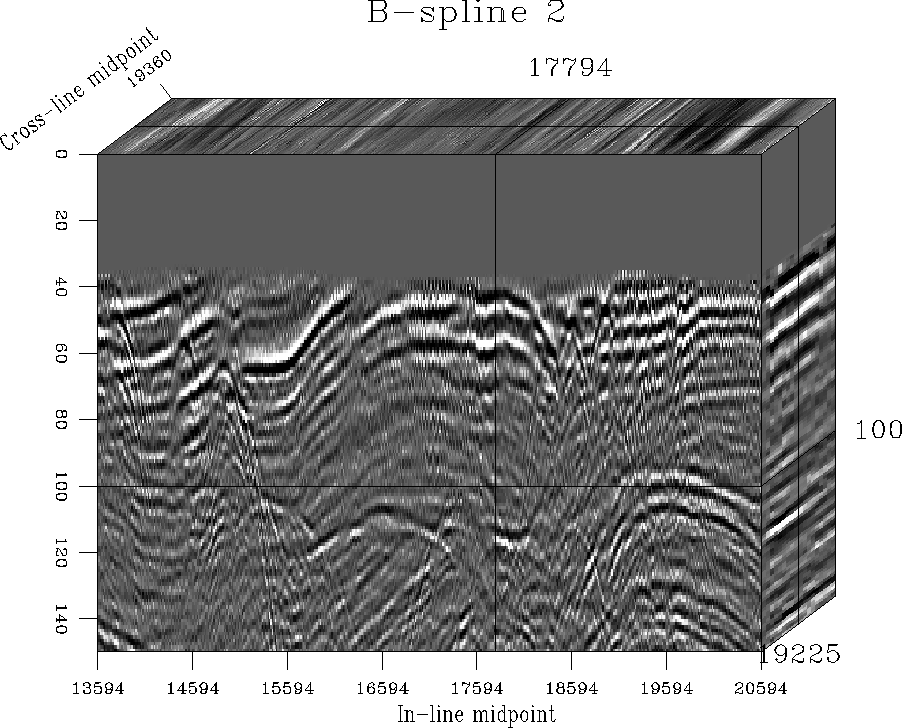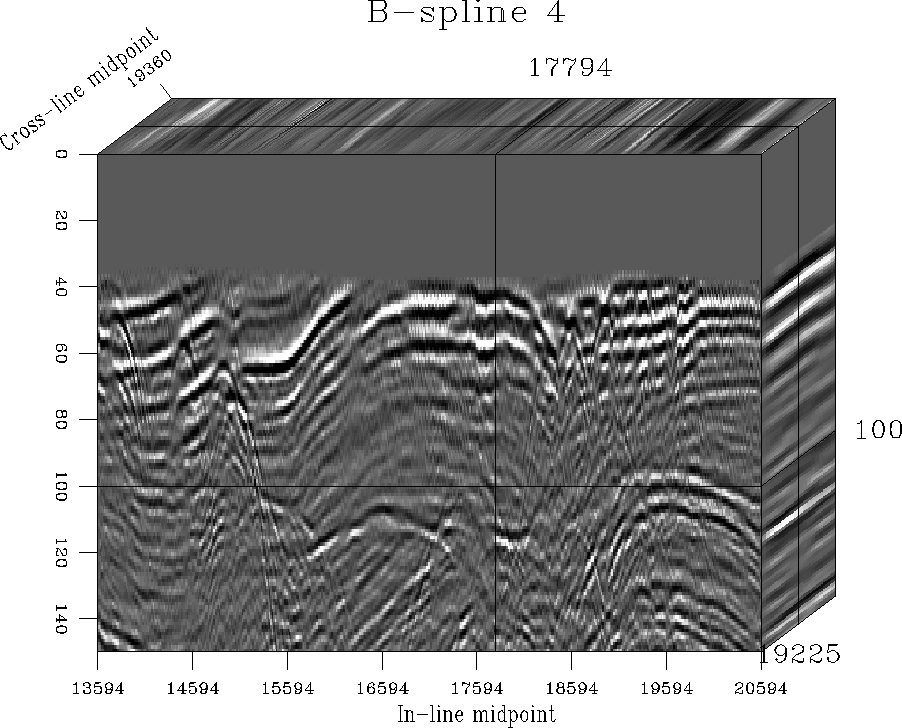




Next: Conclusions
Up: Inverse Interpolation and Data
Previous: Test example
In this subsection, I demonstrate an application of B-spline inverse
interpolation for regularizing three-dimensional seismic reflection
data. The dataset of this example comes from the North Sea and was
used before for testing AMO Biondi et al. (1998) and common-azimuth
migration Biondi (1996). Figure ![[*]](http://sepwww.stanford.edu/latex2html/cross_ref_motif.gif) shows the
midpoint geometry and the corresponding bin fold for a selected range
of offsets and azimuths. The goal of data regularization is to create
a regular data cube at the specified bins from the irregular input
data, preprocessed by NMO. As typical of marine acquisition, the fold
distribution is fairly regular but has occasional gaps caused by the
cable feathering effect.
cmpfold
shows the
midpoint geometry and the corresponding bin fold for a selected range
of offsets and azimuths. The goal of data regularization is to create
a regular data cube at the specified bins from the irregular input
data, preprocessed by NMO. As typical of marine acquisition, the fold
distribution is fairly regular but has occasional gaps caused by the
cable feathering effect.
cmpfold
Figure 33 Midpoint geometry (left) and
fold distribution (right) for the 3-D data test





The data cube after normalized binning (inverse nearest neighbor
interpolation) is shown in Figure ![[*]](http://sepwww.stanford.edu/latex2html/cross_ref_motif.gif) . Binning works
reasonably well in the areas of large fold but fails to fill the zero
fold gaps and has an overall limited accuracy.
. Binning works
reasonably well in the areas of large fold but fails to fill the zero
fold gaps and has an overall limited accuracy.
bin1
Figure 34 3-D data after normalized binning





Inverse interpolation using bi-linear interpolants significantly
improves the result (Figure ![[*]](http://sepwww.stanford.edu/latex2html/cross_ref_motif.gif) ), and inverse B-spline
interpolation improves the accuracy even further
(Figure
), and inverse B-spline
interpolation improves the accuracy even further
(Figure ![[*]](http://sepwww.stanford.edu/latex2html/cross_ref_motif.gif) ). In both cases, I regularized the data in
constant time slices, using recursive filter preconditioning with
plane-wave destructor filters analogous to those in
Figure
). In both cases, I regularized the data in
constant time slices, using recursive filter preconditioning with
plane-wave destructor filters analogous to those in
Figure ![[*]](http://sepwww.stanford.edu/latex2html/cross_ref_motif.gif) . The plane wave slope was estimated from the
binned data with the method of Fomel (2000a). The
inverse interpolation results preserve both flat reflection events in
the data and steeply-dipping diffractions. When data regularization is
used as a preprocessing step for common-azimuth migration
Biondi and Palacharla (1996), preserving diffractions is important for
correct imaging of sharp edges in the subsurface structure.
. The plane wave slope was estimated from the
binned data with the method of Fomel (2000a). The
inverse interpolation results preserve both flat reflection events in
the data and steeply-dipping diffractions. When data regularization is
used as a preprocessing step for common-azimuth migration
Biondi and Palacharla (1996), preserving diffractions is important for
correct imaging of sharp edges in the subsurface structure.
int2
Figure 35 3-D data after inverse interpolation with
bi-linear interpolants




 int4
int4
Figure 36 3-D data after inverse interpolation with
third-order B-spline interpolants










Next: Conclusions
Up: Inverse Interpolation and Data
Previous: Test example
Stanford Exploration Project
11/9/2000

![[*]](http://sepwww.stanford.edu/latex2html/cross_ref_motif.gif) shows the
midpoint geometry and the corresponding bin fold for a selected range
of offsets and azimuths. The goal of data regularization is to create
a regular data cube at the specified bins from the irregular input
data, preprocessed by NMO. As typical of marine acquisition, the fold
distribution is fairly regular but has occasional gaps caused by the
cable feathering effect.
shows the
midpoint geometry and the corresponding bin fold for a selected range
of offsets and azimuths. The goal of data regularization is to create
a regular data cube at the specified bins from the irregular input
data, preprocessed by NMO. As typical of marine acquisition, the fold
distribution is fairly regular but has occasional gaps caused by the
cable feathering effect.

![[*]](http://sepwww.stanford.edu/latex2html/cross_ref_motif.gif) . Binning works
reasonably well in the areas of large fold but fails to fill the zero
fold gaps and has an overall limited accuracy.
. Binning works
reasonably well in the areas of large fold but fails to fill the zero
fold gaps and has an overall limited accuracy.

![[*]](http://sepwww.stanford.edu/latex2html/cross_ref_motif.gif) ), and inverse B-spline
interpolation improves the accuracy even further
(Figure
), and inverse B-spline
interpolation improves the accuracy even further
(Figure ![[*]](http://sepwww.stanford.edu/latex2html/cross_ref_motif.gif) ). In both cases, I regularized the data in
constant time slices, using recursive filter preconditioning with
plane-wave destructor filters analogous to those in
Figure
). In both cases, I regularized the data in
constant time slices, using recursive filter preconditioning with
plane-wave destructor filters analogous to those in
Figure ![[*]](http://sepwww.stanford.edu/latex2html/cross_ref_motif.gif) . The plane wave slope was estimated from the
binned data with the method of Fomel (2000a). The
inverse interpolation results preserve both flat reflection events in
the data and steeply-dipping diffractions. When data regularization is
used as a preprocessing step for common-azimuth migration
Biondi and Palacharla (1996), preserving diffractions is important for
correct imaging of sharp edges in the subsurface structure.
. The plane wave slope was estimated from the
binned data with the method of Fomel (2000a). The
inverse interpolation results preserve both flat reflection events in
the data and steeply-dipping diffractions. When data regularization is
used as a preprocessing step for common-azimuth migration
Biondi and Palacharla (1996), preserving diffractions is important for
correct imaging of sharp edges in the subsurface structure.

